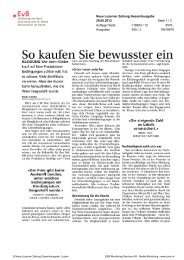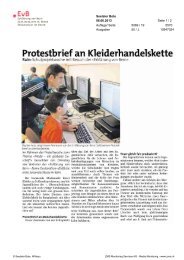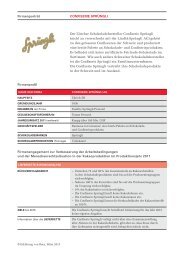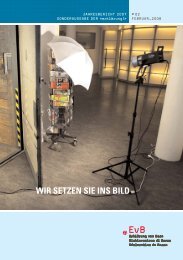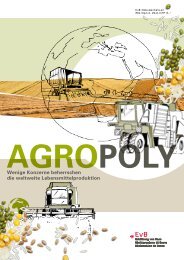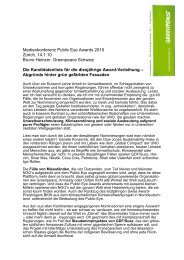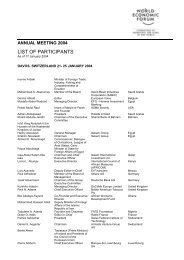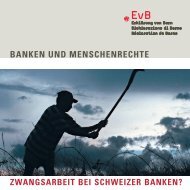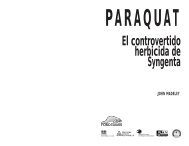Maid in India
Maid in India
Maid in India
Create successful ePaper yourself
Turn your PDF publications into a flip-book with our unique Google optimized e-Paper software.
<strong>Maid</strong> <strong>in</strong> <strong>India</strong><br />
1. Introduction<br />
1.1. Background<br />
The Centre for Research on Mult<strong>in</strong>ational Corporations (SOMO) and the <strong>India</strong> Committee of the<br />
Netherlands (ICN) published the report ‘Captured by Cotton – Exploited Dalit girls produce<br />
garments <strong>in</strong> <strong>India</strong> for European and US markets’ 4 <strong>in</strong> May 2011. The report describes how products<br />
for big garment brands and retailers are made by girls and young women from Dalit and low caste<br />
backgrounds under exploitative work<strong>in</strong>g conditions <strong>in</strong> Tamil Nadu, South <strong>India</strong>. The report revealed<br />
that a great number of these young women are employed under the so-called ‘Sumangali Scheme’.<br />
This exploitative scheme is tantamount to bonded labour, because employers withhold part of the<br />
workers’ wages until they have worked there for three to five years. In addition it was found that<br />
workers are severely restricted <strong>in</strong> their freedom of movement and privacy.<br />
‘Captured by Cotton’ zoomed <strong>in</strong> on four vertically <strong>in</strong>tegrated manufacturers: Bannari Amman,<br />
Eastman Exports Global Cloth<strong>in</strong>g, K.P.R. Mill and SSM <strong>India</strong>. These manufacturers supply to a<br />
large group of European and US brands and retailers. ‘Captured by Cotton’ revealed that these<br />
manufacturers employed workers under the Sumangali Scheme. Other unacceptable labour<br />
practices described <strong>in</strong> ‘Captured by Cotton’ <strong>in</strong>cluded: excessive and forced overwork; unsafe and<br />
unhealthy work<strong>in</strong>g conditions; and the employment of children younger than the legal work<strong>in</strong>g age.<br />
Freedom of association and collective barga<strong>in</strong><strong>in</strong>g proved to be non-existent and none of the<br />
researched manufacturers had effective and <strong>in</strong>dependent grievance mechanisms <strong>in</strong> place, leav<strong>in</strong>g<br />
workers without any effective channel to express their grievances and resolve them.<br />
The common denom<strong>in</strong>ator of corporate responses to the labour issues described <strong>in</strong> ‘Captured by<br />
Cotton’ is a general acknowledgement of the need to address these issues, and where possible to<br />
do so collectively, <strong>in</strong>volv<strong>in</strong>g multiple stakeholders <strong>in</strong> order to effectively work towards<br />
improvements.<br />
It must be noted, however, that more than half of the companies named <strong>in</strong> ‘Captured by Cotton’<br />
refused to engage on the topic with SOMO and ICN. 5<br />
The publication of ‘Captured by Cotton’ by SOMO and ICN followed on research and publications<br />
by Anti-Slavery International and the European Coalition for Corporate Justice (ECCJ), as well as<br />
various media publications, and has added to the public body of knowledge regard<strong>in</strong>g the<br />
occurrence of bonded labour <strong>in</strong> the Tamil Nadu garment and textile <strong>in</strong>dustry.<br />
1.2. Follow-up report - aims and objectives<br />
Follow<strong>in</strong>g up on ‘Captured by Cotton’, SOMO and ICN have commissioned new research which is<br />
reflected <strong>in</strong> the present report. This report provides an update of labour conditions <strong>in</strong> the Tamil<br />
Nadu garment and textile <strong>in</strong>dustry and exam<strong>in</strong>es the current situation at the four garment<br />
4<br />
5<br />
Centre for Research on Mult<strong>in</strong>ational Corporations (SOMO) and the <strong>India</strong> Committee of the Netherlands (ICN), ‘Captured<br />
by Cotton – Exploited Dalit girls produce garments <strong>in</strong> <strong>India</strong> for European and US markets’, Amsterdam, the Netherlands,<br />
May 2011, < http://somo.nl/publications-en/Publication_3673 ><br />
Out of the 37 brands and retailers mentioned <strong>in</strong> ‘Captured by Cotton’, 19 did not respond. In September 2011, SOMO<br />
and ICN, together with a group of <strong>India</strong>n and <strong>in</strong>ternational NGOs, sent a letter to those 19 companies, urg<strong>in</strong>g them to<br />
respond to the concerns raised by SOMO and ICN. Out of these 19 companies, only 7 companies responded.<br />
10



